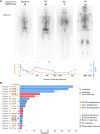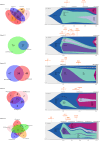Sequential Analysis of cfDNA Reveals Clonal Evolution in Patients with Neuroblastoma Receiving ALK-Targeted Therapy
- PMID: 38787533
- PMCID: PMC11292203
- DOI: 10.1158/1078-0432.CCR-24-0753
Sequential Analysis of cfDNA Reveals Clonal Evolution in Patients with Neuroblastoma Receiving ALK-Targeted Therapy
Abstract
Purpose: The study of cell-free DNA (cfDNA) enables sequential analysis of tumor cell-specific genetic alterations in patients with neuroblastoma.
Experimental design: Eighteen patients with relapsing neuroblastoma having received lorlatinib, a third-generation ALK inhibitor, were identified (SACHA national registry and/or in the institution). cfDNA was analyzed at relapse for nine patients and sequentially for five patients (blood/bone marrow plasma) by performing whole-genome sequencing library construction followed by ALK-targeted ddPCR of the hotspot mutations [F1174L, R1275Q, and I1170N; variant allele fraction (VAF) detection limit 0.1%] and whole-exome sequencing (WES) to evaluate disease burden and clonal evolution, following comparison with tumor/germline WES.
Results: Overall response rate to lorlatinib was 33% (CI, 13%-59%), with response observed in 6/10 cases without versus 0/8 cases with MYCN amplification (MNA). ALK VAFs correlated with the overall clinical disease status, with a VAF < 0.1% in clinical remission, versus higher VAFs (>30%) at progression. Importantly, sequential ALK ddPCR detected relapse earlier than clinical imaging. cfDNA WES revealed new SNVs, not seen in the primary tumor, in all instances of disease progression after lorlatinib treatment, indicating clonal evolution, including alterations in genes linked to tumor aggressivity (TP53) or novel targets (EGFR). Gene pathway analysis revealed an enrichment for genes targeting cell differentiation in emerging clones, and cell adhesion in persistent clones. Evidence of clonal hematopoiesis could be observed in follow-up samples.
Conclusions: We demonstrate the clinical utility of combining ALK cfDNA ddPCR for disease monitoring and cfDNA WES for the study of clonal evolution and resistance mechanisms in patients with neuroblastoma receiving ALK-targeted therapy.
©2024 The Authors; Published by the American Association for Cancer Research.
Conflict of interest statement
C. Butterworth reports grants from the European Union’s Horizon 2020 research and innovation program under the Marie Skłodowska-Curie grant agreement, No. 956285—VAGABOND ITN, during the conduct of the study. P. Berlanga reports other support from EUSA Pharma and grants from Bayer outside the submitted work. G. Schleiermacher reports grants from Annenberg Foundation, Association Hubert Gouin Enfance et Cancer, Fédération Enfants Cancers Santé, Imagine For Margo, Fondation ARC pour la Recherche contre le Cancer, Les Bagouz à Manon, PHRC IC2007-09, PRTK 18-035, Joint Transnational Call for Proposals 2017 (JTC 2017): “Translational research on rare cancers,” and NBUK (registered Charity No. 326385) and the Friends of Rosie (registered Charity No. 1046278) during the conduct of the study, as well as grants from Roche, MSDavenir, BMS, and Pfizer outside the submitted work. No disclosures were reported by the other authors.
Figures





References
-
- Matthay KK, Maris JM, Schleiermacher G, Nakagawara A, Mackall CL, Diller L, et al. . Neuroblastoma. Nat Rev Dis Primers 2016;2:16078. - PubMed
-
- Gröbner SN, Worst BC, Weischenfeldt J, Buchhalter I, Kleinheinz K, Rudneva VA, et al. . The landscape of genomic alterations across childhood cancers. Nature 2018;555:321–7. - PubMed
-
- Bellini A, Bernard V, Leroy Q, Rio Frio T, Pierron G, Combaret V, et al. . Deep sequencing reveals occurrence of subclonal ALK mutations in neuroblastoma at diagnosis. Clin Cancer Res 2015;21:4913–21. - PubMed
MeSH terms
Substances
Grants and funding
- Annenberg Foundation
- French National Agency for the Safety of Medicine and Health Products (ANSM)
- Societe Française de Lutte Contre les Cancers et Leucémies de L'enfants et L'adolescent
- Fondation des Entreprises du Medicament
- Association Hubert Gouin Enfance et Cancer (Hubert Gouin Association)
- Federation Enfants Cancers Sante
- Imagine for Margo
- Les Bagouz a Manon
- Fondation ARC pour la Recherche sur le Cancer (ARC)
- INCa grant PHRC IC2007-09/Institut National Du Cancer (INCa)
- ANR-10-EQPX-03 (Equipex) and ANR-10-INBS-09-08 (France Génomique Consortium)/Agence Nationale de la Recherche (ANR)
- Cancéropole Ile de France
- Joint Transnational Call for Proposals 2017 (JTC 2017)
- Neuroblastoma UK
- Friends of Rosie
LinkOut - more resources
Full Text Sources
Medical
Research Materials
Miscellaneous

